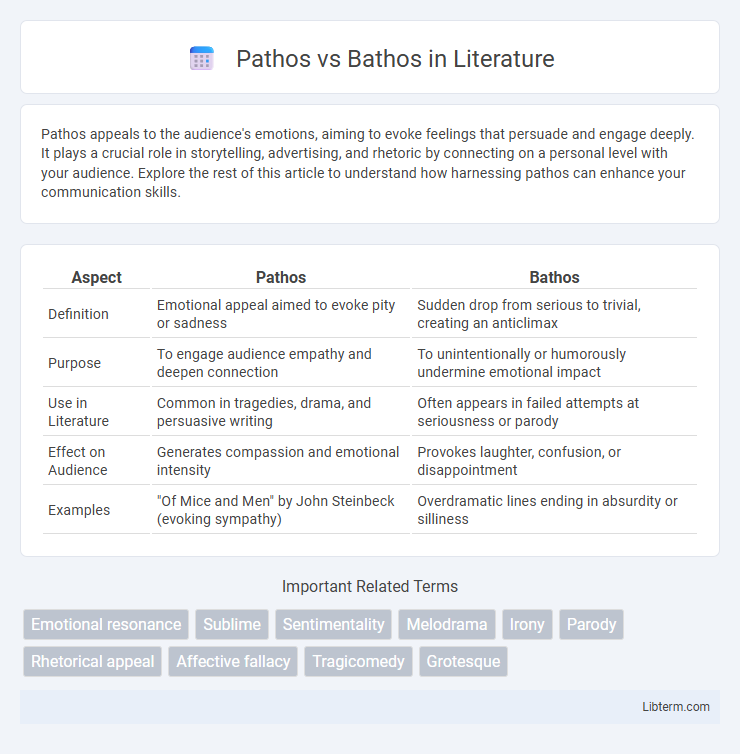Pathos appeals to the audience's emotions, aiming to evoke feelings that persuade and engage deeply. It plays a crucial role in storytelling, advertising, and rhetoric by connecting on a personal level with your audience. Explore the rest of this article to understand how harnessing pathos can enhance your communication skills.
Table of Comparison
| Aspect | Pathos | Bathos |
|---|---|---|
| Definition | Emotional appeal aimed to evoke pity or sadness | Sudden drop from serious to trivial, creating an anticlimax |
| Purpose | To engage audience empathy and deepen connection | To unintentionally or humorously undermine emotional impact |
| Use in Literature | Common in tragedies, drama, and persuasive writing | Often appears in failed attempts at seriousness or parody |
| Effect on Audience | Generates compassion and emotional intensity | Provokes laughter, confusion, or disappointment |
| Examples | "Of Mice and Men" by John Steinbeck (evoking sympathy) | Overdramatic lines ending in absurdity or silliness |
Understanding Pathos: Definition and Purpose
Pathos, derived from Greek rhetoric, refers to the emotional appeal used to persuade an audience by evoking feelings such as pity, sadness, or passion. Its purpose is to establish a connection between the speaker or writer and the audience, making the message more compelling and memorable. Effective use of pathos enhances persuasion by tapping into the audience's emotions, often influencing beliefs and motivating action.
Exploring Bathos: Meaning and Origins
Bathos, originating from the Greek word meaning "depth," refers to an abrupt shift from the serious or sublime to the trivial or ridiculous, often resulting in unintended humor or anticlimax. Unlike pathos, which evokes genuine emotion and empathy, bathos undermines emotional intensity by descending into absurdity or sentimentality. This literary technique gained prominence in the 18th century through critics like Alexander Pope, who used bathos to satirize overwrought or exaggerated emotional appeals.
Key Differences Between Pathos and Bathos
Pathos evokes strong emotions such as pity, sorrow, or sympathy to persuade or connect with an audience, often used in rhetoric and literature. Bathos, however, refers to an abrupt shift from the sublime or serious to the ridiculous or trivial, creating an unintended humorous or anticlimactic effect. The key difference lies in pathos's intentional emotional appeal, while bathos results from a failed attempt to maintain emotional intensity, leading to a jarring or comedic outcome.
Emotional Impact: Pathos in Literature and Rhetoric
Pathos in literature and rhetoric intensifies emotional impact by appealing directly to the audience's feelings, often evoking empathy, sadness, or passion to persuade or move readers. It strategically uses vivid imagery, poignant anecdotes, and emotionally charged language to create a deep connection between the message and the audience's experiences. Unlike bathos, which unintentionally undermines emotional appeal through excessive sentimentality or triviality, pathos maintains sincerity and depth, enhancing the persuasive power of storytelling and argumentation.
The Unintended Humor of Bathos
Bathos arises when an attempt at pathos unintentionally descends into absurdity or triviality, creating humor instead of emotional resonance. This inadvertent shift undermines the intended seriousness, often eliciting laughter due to the exaggerated or misplaced sentiment. The comedic effect of bathos highlights the fine line between profound emotional appeal and overdone, clumsy expression.
Classic Examples of Pathos in Media
Classic examples of pathos in media are found in films like "Schindler's List," where emotional storytelling evokes deep empathy for Holocaust victims, and in Martin Luther King Jr.'s "I Have a Dream" speech, which stirs hope through vivid imagery and heartfelt appeals. Literature such as Charles Dickens' "A Christmas Carol" employs pathos by portraying Ebenezer Scrooge's transformation, igniting compassion and moral reflection. These instances demonstrate pathos as a powerful rhetorical tool designed to connect audiences emotionally and inspire action or change.
Illustrative Instances of Bathos Gone Wrong
Bathos often fails when emotional appeals become exaggerated or insincere, resulting in unintended humor instead of pathos. An illustrative instance is the 2004 film "Catwoman," where attempts at dramatic intensity veered into absurdity, undermining audience connection. Another example is political speeches that shift abruptly from serious issues to trivial anecdotes, causing emotional impact to collapse and provoke ridicule.
How to Use Pathos Effectively in Writing
To use pathos effectively in writing, evoke strong emotions by creating vivid imagery and relatable scenarios that connect with readers' values and experiences. Incorporate storytelling techniques and expressive language to build empathy and engage the audience on a personal level. Balancing emotional appeal with logical arguments ensures the message resonates deeply without overshadowing the core purpose.
Avoiding Bathos: Tips for Maintaining Tone
Maintaining tone requires carefully balancing emotions to avoid bathos, which arises when serious content inadvertently becomes trivial or ridiculous. Use consistent language and imagery aligned with the intended emotional appeal to preserve pathos effectively. Monitoring audience reactions and revising key passages can prevent unintentional shifts from sincere pathos to undermining bathos.
Pathos vs Bathos: Why Distinguishing Matters
Understanding the difference between pathos and bathos is essential for effective communication and emotional impact. Pathos evokes genuine emotions and deep empathy in an audience, while bathos results in unintentional humor or anticlimax, disrupting the intended emotional tone. Distinguishing between these ensures that messages resonate authentically without undermining credibility or emotional engagement.
Pathos Infographic

 libterm.com
libterm.com